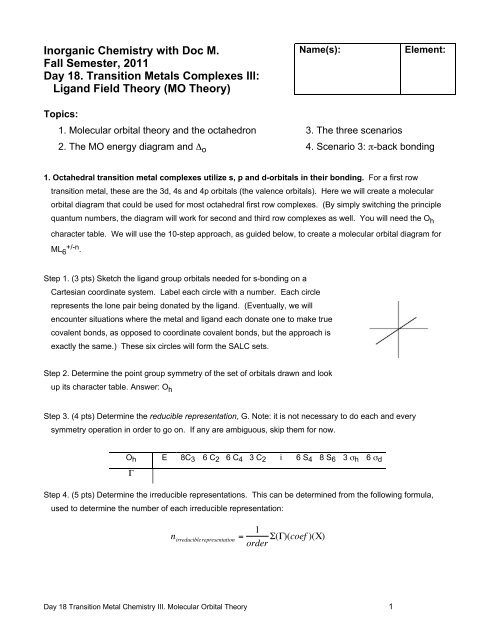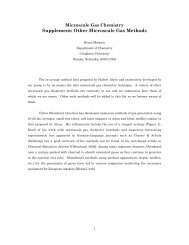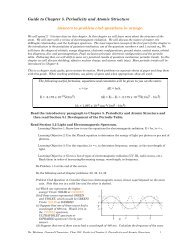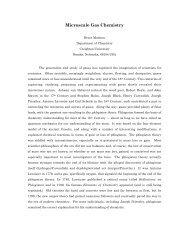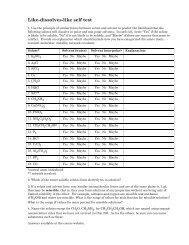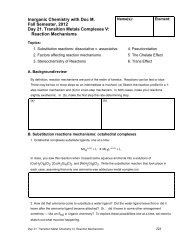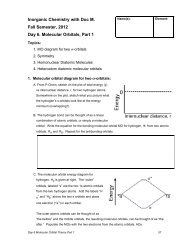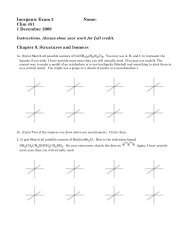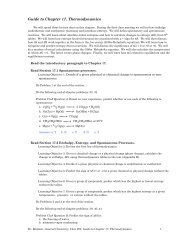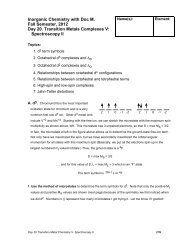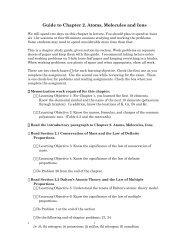Element - Mattson
Element - Mattson
Element - Mattson
You also want an ePaper? Increase the reach of your titles
YUMPU automatically turns print PDFs into web optimized ePapers that Google loves.
Inorganic Chemistry with Doc M.<br />
Fall Semester, 2011<br />
Day 18. Transition Metals Complexes III:<br />
Ligand Field Theory (MO Theory)<br />
Topics:<br />
Name(s):<br />
1. Molecular orbital theory and the octahedron 3. The three scenarios<br />
Day 18 Transition Metal Chemistry III. Molecular Orbital Theory 1<br />
<strong>Element</strong>:<br />
2. The MO energy diagram and Δ o 4. Scenario 3: π-back bonding<br />
1. Octahedral transition metal complexes utilize s, p and d-orbitals in their bonding. For a first row<br />
transition metal, these are the 3d, 4s and 4p orbitals (the valence orbitals). Here we will create a molecular<br />
orbital diagram that could be used for most octahedral first row complexes. (By simply switching the principle<br />
quantum numbers, the diagram will work for second and third row complexes as well. You will need the O h<br />
character table. We will use the 10-step approach, as guided below, to create a molecular orbital diagram for<br />
ML 6 +/-n .<br />
Step 1. (3 pts) Sketch the ligand group orbitals needed for s-bonding on a<br />
Cartesian coordinate system. Label each circle with a number. Each circle<br />
represents the lone pair being donated by the ligand. (Eventually, we will<br />
encounter situations where the metal and ligand each donate one to make true<br />
covalent bonds, as opposed to coordinate covalent bonds, but the approach is<br />
exactly the same.) These six circles will form the SALC sets.<br />
Step 2. Determine the point group symmetry of the set of orbitals drawn and look<br />
up its character table. Answer: O h<br />
Step 3. (4 pts) Determine the reducible representation, G. Note: it is not necessary to do each and every<br />
symmetry operation in order to go on. If any are ambiguous, skip them for now.<br />
Oh E 8C3 6 C2 6 C4 3 C2 i 6 S4 8 S6 3 σh 6 σd<br />
Γ<br />
Step 4. (5 pts) Determine the irreducible representations. This can be determined from the following formula,<br />
used to determine the number of each irreducible representation:<br />
€<br />
n irreduciblerepresentation =<br />
1<br />
Σ(Γ)(coef )(Χ)<br />
order
where “order” is the sum of the coefficients from along the top of the character table (1 + 8 + 6 + 6 + 3 + 1 + 6 +<br />
8 + 3 + 6 = 48 for the Oh character table below), Γ is the familiar reducible contribution and Χ is the character<br />
for each irreducible component.<br />
Oh E 8C3 6 C2 6 C4 3 C2 i 6 S4 8 S6 3 σh 6 σd<br />
You do not need to use this formula (because of the tricks we’ve learned), but if you did use it because the<br />
columns that list how orbitals transform was missing, for example, the calculation would look like this for the first<br />
irreducible representation for Oh, namely a 1g :<br />
na 1g = [(6)(1)(1) +(0)(8)(1) +(0)(6)(1) +(2)(6)(1) +(2)(3)(1) +(0)(1)(1) +(0)(6)(1) +(0)(8)(1) +(4)(3)(1) +(2)(6)(1)]/48<br />
= 1<br />
na 2g = [(6)(1)(1) +(0)(8)(1) +(0)(6)(-1) +(2)(6)(-1) +(2)(3)(1) +(0)(1)(1) +(0)(6)(-1) +(0)(8)(1) +(4)(3)(1) +(2)(6)(-1)]/48<br />
= 0<br />
Continuing on, determine how many e g irreducible representations are present, and so on. Using the formula or<br />
making educated guesses, finish determining what the irreducible components are for the SALC orbitals in an<br />
octahedral arrangement.<br />
Day 18 Transition Metal Chemistry III. Molecular Orbital Theory 2
Step 5. (6 pts) Sketch each of the 6 SALCs (no orbitals from the metal!) with appropriate symmetry labels. Shade<br />
in the appropriate lobes of the SALC sets. Complete the table on the next page summarizing how the atomic<br />
orbitals are deployed to form the SALCs.<br />
(symmetry) AO #1 AO #2 AO #3 AO #4 AO #5 AO #6 Total:<br />
SALC ( ) =1<br />
SALC ( ) =1<br />
SALC ( ) =1<br />
SALC ( ) =1<br />
SALC ( ) =1<br />
SALC ( ) =1<br />
Total: =1 =1 =1 =1 =1 =1<br />
Step 6. (3 pts) List all the metal atom’s valence orbitals (there are 9: the 4s, the three 4ps and the five 3ds) and<br />
assign each one a symmetry label. The first one is done for you.<br />
4s (a 1g )<br />
Step 7. (8 pts) Create a MO energy diagram. Start with the correct relative energies! For the metal (sketch AOs<br />
on the left side of diagram), the 3d orbitals are lowest in energy providing the metal is a cation, which is almost<br />
always the case. The 4s orbital is next lowest in energy and the 4p orbitals are the highest. The ligands have<br />
electron pairs and are usually quite content with or without a metal — evidence that the energy of the donating<br />
electron pair isn’t too high. As a “general” rule, you can sketch the energies of the six SALCs somewhere near<br />
Day 18 Transition Metal Chemistry III. Molecular Orbital Theory 3
in energy to the lowest of the metal’s valence orbitals. I will be checking for labels and for how you connect the<br />
atomic and SALC orbitals with lines.<br />
Step 8. (6 pts) Sketch molecular orbital line drawings from overlapping SALCs from Step 5 with the symmetry<br />
appropriate AOs from Step 6. Just sketch the bonding interactions — skip the antibonding. You can do it here<br />
or, if you prefer, add them to the MO energy diagram above.<br />
Step 9. (3 pts) Double check to see if you have conserved orbitals.<br />
Day 18 Transition Metal Chemistry III. Molecular Orbital Theory 4
B. Using the MO energy diagram. Populate the MO diagram (sketched in Step 7, above) for the<br />
complex Cr(NH 3 ) 6 +3 .<br />
i. To do so, you should first determine how many electrons are coming from the Cr +3 and how many are coming<br />
form the six ammonia ligands. Do your math here:<br />
ii. Write the electron configuration here using the notation (a 1g ) 2 (e g ) 4 etc.<br />
iii. Write electron configurations for these complexes:<br />
Co(H 2 O) 6 +2<br />
VCl 6 -4<br />
Fe(py) 6 +3<br />
iv. Draw a box around the HOMO and LUMO orbitals in the energy diagram (page 3) — that<br />
represent the crystal field orbital energy splitting pattern. Remember this connection! Label Δ o .<br />
C. The three scenarios for the MO energy diagram.<br />
Scenario #1. Weak field ligands. When Δ o is small as is the case with weak field ligands (see the<br />
Spectrochemical Series from the previous worksheet.), the e g orbitals are not out of reach from energy<br />
considerations. Since the ligands are “good for” 6 x 2 = 12 electrons, and the metal cation can have between<br />
zero and ten valence electrons, the MO diagram can have between 12 and 22 electrons populating it.<br />
Complete the chart. In the third row, list at least two common examples of metals.<br />
d 0 d 1<br />
12 e - 13 e -<br />
Sc +3<br />
Ti +4<br />
Scenario #2. Strong field ligands. When Δ o is larger as is the case with _______ field ligands, the e g<br />
orbitals are generally too high in energy (too antibonding). Populating them is not done very often, although<br />
examples exist. As usual, the ligands deliver 12 electrons. This limits the metal cation. It can donate between<br />
_______ and _______ electrons. Thus, the range in total electrons in the molecular orbital diagram is between<br />
Day 18 Transition Metal Chemistry III. Molecular Orbital Theory 5
_____ and ______ electrons. Draw a dark vertical line through the table above marking this “cut-off.” Metal<br />
ions with more than this number of electrons will have some bonding issues — such as they are easily oxidized.<br />
Scenario 3. π-back bonding. Certain ligands,<br />
specifically those with π-bonding, are capable of a new<br />
interaction with transition metal d-orbitals. Let’s discover<br />
how this works.<br />
Recall the molecular orbital diagram’s we created for<br />
diatomics back on Day 6 – 8. Sketch such a diagram for<br />
cyanide and populate it.<br />
Label the HOMO and LUMO.<br />
Next, sketch the Lewis dot structure for cyanide and<br />
assign formal charges to each atom. From the standpoint<br />
of formal charges, does cyanide coordinate to the metal<br />
via the carbon or nitrogen atom?<br />
The lone pair on carbon corresponds to an sp-orbital from the standpoint of Lewis dot and valence bond theory<br />
(the theory that brought us hybridization.) It also corresponds to the HOMO in terms of molecular orbital theory.<br />
In either case, the electron pair is the Lewis base pair that is donated to the Lewis acid metal. The bond is a<br />
coordinate-covalent bond (both electrons from the same donor) and this sort of interaction is called σ-donation<br />
by the ligand. When we drew the molecular orbital structure for the octahedral metal complex above, the SALC<br />
set consisted of six of these σ-donation orbitals. In terms of hybridization, for ammonia the SALCs would be the<br />
sp 3 orbitals. What hybrid orbitals would be used for σ-bonding from cyanide to the metal?<br />
Oxygen is transported through the blood by an octahedral Fe +2 in hemoglobin. What orbital would be used for<br />
σ-donation by a coordinated O 2 ligand?<br />
Back to cyanide. The LUMO orbital is the π* orbital. Sketch it here.<br />
Day 18 Transition Metal Chemistry III. Molecular Orbital Theory 6
This empty orbital has the right symmetry to overlap with a t 2g orbital on the metal. Add this π* - t 2g interaction<br />
to your π* sketch in the box above.<br />
Prior to this, the t 2g orbitals were non-<br />
bonding, but for ligands with π-bonding<br />
and thus π* orbitals, this new interaction<br />
is possible. Copy your MO diagram<br />
sketched above here, but do not<br />
populate it and leave off the t 2g non-<br />
bonding orbitals.<br />
To start, Let’s consider the relative<br />
energies of the SALC set of σ-donors<br />
and the empty π* orbitals on the<br />
ligands. The answer is simple: they are<br />
exactly the same as they were in your<br />
MO diagram for cyanide above!<br />
Relative to the metal’s d-orbitals, the π*<br />
orbitals are at about the same energy<br />
level as the empty s- and p-orbitals on<br />
the metal.<br />
For cyanide and carbon monoxide, there is a triple<br />
bond: two p-bonds and two π-antibonds. (For ligands<br />
with only a double bond, there is only one p and p*<br />
bond.) Thus, for a SALC set for cyanide, there are 6<br />
x 2 = 12 π* orbitals, Sketch an octahedron, and to the<br />
best of your ability, sketch the 12 π* orbitals that<br />
would be used to form the SALC orbitals.<br />
We could go through the usual drill where we perform the octahedral symmetry operations on the 12 π*<br />
orbitals and then use that to produce the irreducible representations, however, it takes a long time and you<br />
wouldn’t learn anything that you don’t already know in terms of procedure. What does come out of this workup,<br />
however is a triply degenerate irreducible representation with the same symmetry as the metal’s t 2g orbitals —<br />
and a bunch of other sets that are all non-bonding with s, p and d-orbitals (no additional symmetry-allowed<br />
sets.)<br />
Day 18 Transition Metal Chemistry III. Molecular Orbital Theory 7
The next step, as you recall, was to sketch<br />
the MOs and to place them in the energy diagram.<br />
Sketch just one of the three equivalent MO drawings<br />
(all in one plane) — the result of one of the metals<br />
t 2g d-orbitals overlapping with four π* orbitals, all<br />
within the same plane. Sketch the MO here.<br />
Is the bonding interaction that you sketched between<br />
metal and SALC best described as σ or π in nature?<br />
Suppose the one you sketched featured the d yz orbital and your MO bonding sketch was in the yz-plane (the<br />
plane of this paper.) There are two equivalent MO bonding schemes in the d xz and d xz planes. Considering<br />
the first one again — the one you sketched, what fraction of each π* orbital from each ligand participates in<br />
each MO? In other words, if we looked at this one t 2g SALC set (in the yz plane) and recalling that the<br />
contributing atomic orbitals must sum to 1, what fraction of each ligand π* would you use from each ligand to<br />
make the SALC set to overlap with the d yz ?<br />
All together, how many “orbital equivalents” out of the twelve SALCs that we started with are involved in this<br />
sort of bonding? The rest of these are non-bonding orbitals.<br />
Finish the MO energy diagram now and populate it for Fe(CN) 6 -4 .<br />
The π-bonding interaction that we have just explored features electrons from the filled t 2g orbitals being<br />
distributed out to the ligand’s π* orbitals. Just as we used s-donation to describe the ligand donating electrons<br />
to the metal, this π interaction of metal’s electrons back to the ligand’s π* orbitals is called π-back bonding.<br />
Phosphine and ethane are both capable of π-back bonding. Phosphine uses its empty 3d orbitals. Sketch the<br />
interaction between a filled d xy orbital from the metal and phosphine’s empty 3d xy orbital in an octahedral<br />
complex.<br />
Day 18 Transition Metal Chemistry III. Molecular Orbital Theory 8
The π-back bonding is more important if the ligand has electron withdrawing groups such as fluorine atoms.<br />
Thus, PF 3 is better at p-back bonding than is P(CH 3 ) 3 . So, comparing CN - and CO, why do you suppose that<br />
CO is much better at π-back bonding than cyanide?<br />
In an upcoming worksheet we will learn that it the metal is in a low oxidation state, π-back bonding is more<br />
significant. Why is this so?<br />
1. The molecular orbitals for octahedral metal<br />
complexes are constructed by a linear<br />
combination of ligand group orbitals and which<br />
atomic orbitals of the metal?<br />
(a) ns + np x + np y + np z + (n-1)d x 2 -y 2+ (n-1)d z 2<br />
(b) nd xy + nd xz + nd yz + nd x 2 -y 2+ nd z 2<br />
(c) ns + np x + np y + np z<br />
(d) ns + np x + np y + np z + (n-1)d xy + (n-1)d xz + (n-<br />
1)d yz<br />
(e) np x + np y + np z + nd xy + nd xz + nd yz<br />
2. Rank the d-orbitals from lowest to highest energy<br />
for the trigonal prism.<br />
(a) d xy < d xz < d yz < d x 2 -y 2 < d z 2<br />
(b) (d xy , d x 2 -y 2) < d z 2< (d xz , d yz )<br />
(c) d z 2< (d xz , d xy ) < (d yz , d x 2 -y 2)<br />
(d) d xy < d x 2 -y 2 < d z 2< d xz , < d yz<br />
(e) (d xy , d xz , d yz ) < (d x 2 -y 2, d z 2)<br />
3. What ligand is a p-acceptor and what is the<br />
consequence?<br />
(a) F - ; Δ decreases<br />
(b) F - ; Δ increases<br />
(c) NH 3 ; Δ decreases<br />
(d) NH 3 ; Δ increases<br />
(e) CO; Δ increases<br />
4. Which of the following is a characteristic of pacceptor<br />
ligands?<br />
(a) Δ decreases<br />
(b) Unusually high oxidation states are stabilized<br />
(c) The coordination number is always 6<br />
(d) The ligands have HOMO orbitals with<br />
symmetry allowed overlap with empty dorbitals.<br />
(e) π-acceptor ligands are also σ-donors.<br />
Review for ACS Final Exam<br />
Answers: A, B, E, E<br />
Day 18 Transition Metal Chemistry III. Molecular Orbital Theory 9


